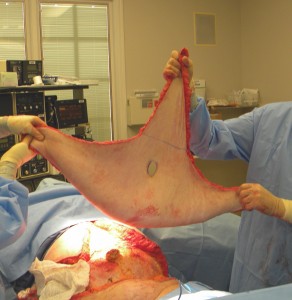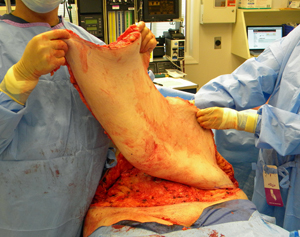The abdominal panniculectomy is a variation to the traditional tummy tuck or abdominoplasty. The pannus or abdominal apron is that overhang of skin and fat that extends below one’s waistline. Abdominal pannuses can exist in overweight as well as extreme weight loss patients after bariatric surgery.
The abdominal panniculectomy, historically, refers to the pre-bariatric surgery era when extremely overweight patients had large skin and fat overhangs. Heavy pannuses were surgically removed to relieve the medical symptoms that they caused such as skin irritations and rashes from the moisture and heat that builds up underneath it. With an obese patient, panniculectomies were associated with high wound complication rates due to the size and depth of the cut outs. Such surgical removals of abdominal overhangs today await weight loss through bariatric surgery first, leaving a smaller pannus on a thinner person.

Because of the relief of medical symptoms, the abdominal panniculectomy may be covered by insurance. Since the panniculectomy procedure in the bariatric surgery patient today weighs considerably less and often only involves improvement of an undesired contour, it is often called cosmetic by one’s health insurance. To be considered medically eligible for insurance coverage, there has to be very specific criteria that are met and a documented trail of medical records that substantiate symptoms related to the pannus. Most importantly, photographs must demonstrate that the pannus hangs onto or below the groin creases.
Abdominal panniculectomies remove large surface areas of skin and fat. Because of the amount of excess tissue present, removal may need to extend way into the back and include a vertical cutout as well as that in the horizontal dimension. This does leave long scars but patients with these skin excess problems always feel that it is a good trade-off. The biggest complications from these procedures is a seroma or build-up of fluids which is why drains are needed for several weeks after surgery.
Dr. Barry Eppley
Indianapolis, Indiana



